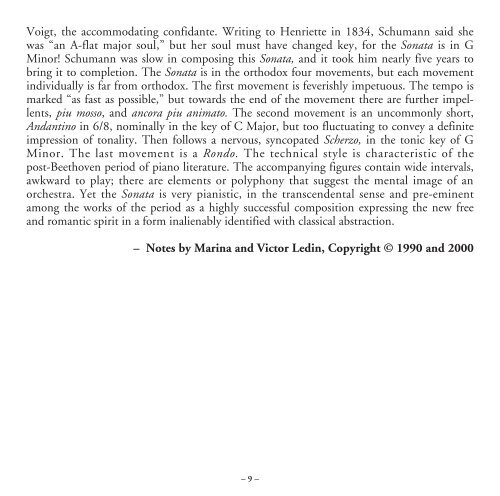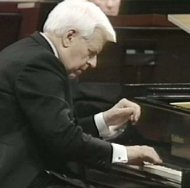Ruth Slenczynskaâ¢SCHUMANN Ruth Slenczynska ... - Ivory Classics
Ruth Slenczynskaâ¢SCHUMANN Ruth Slenczynska ... - Ivory Classics
Ruth Slenczynskaâ¢SCHUMANN Ruth Slenczynska ... - Ivory Classics
You also want an ePaper? Increase the reach of your titles
YUMPU automatically turns print PDFs into web optimized ePapers that Google loves.
Voigt, the accommodating confidante. Writing to Henriette in 1834, Schumann said she<br />
was “an A-flat major soul,” but her soul must have changed key, for the Sonata is in G<br />
Minor! Schumann was slow in composing this Sonata, and it took him nearly five years to<br />
bring it to completion. The Sonata is in the orthodox four movements, but each movement<br />
individually is far from orthodox. The first movement is feverishly impetuous. The tempo is<br />
marked “as fast as possible,” but towards the end of the movement there are further impellents,<br />
piu mosso, and ancora piu animato. The second movement is an uncommonly short,<br />
Andantino in 6/8, nominally in the key of C Major, but too fluctuating to convey a definite<br />
impression of tonality. Then follows a nervous, syncopated Scherzo, in the tonic key of G<br />
Minor. The last movement is a Rondo. The technical style is characteristic of the<br />
post-Beethoven period of piano literature. The accompanying figures contain wide intervals,<br />
awkward to play; there are elements or polyphony that suggest the mental image of an<br />
orchestra. Yet the Sonata is very pianistic, in the transcendental sense and pre-eminent<br />
among the works of the period as a highly successful composition expressing the new free<br />
and romantic spirit in a form inalienably identified with classical abstraction.<br />
– Notes by Marina and Victor Ledin, Copyright © 1990 and 2000<br />
– 9 –














